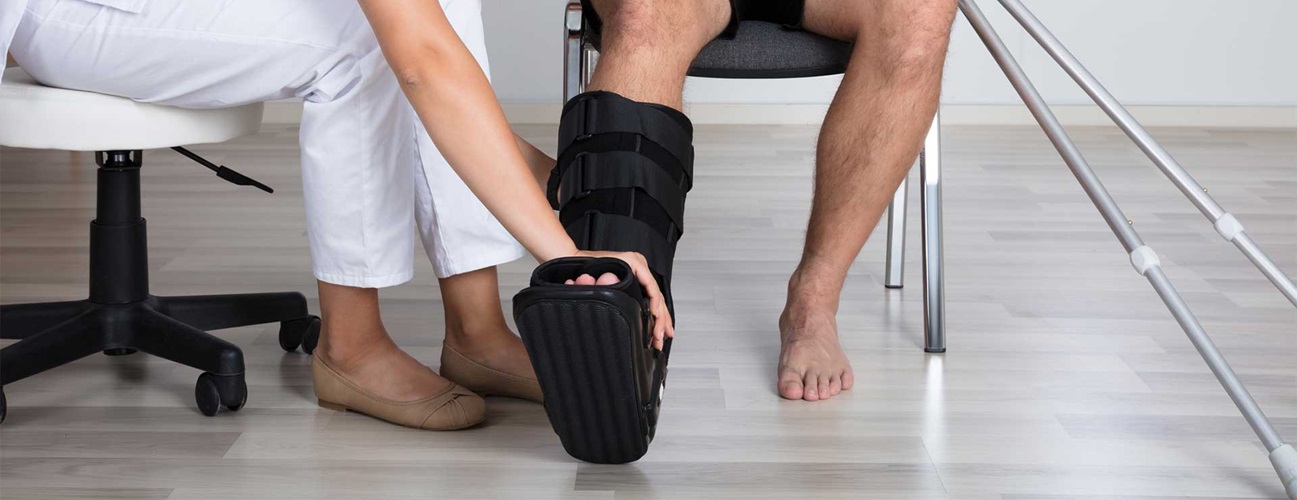Pilon Fracture of the Ankle
What is a pilon fracture of the ankle?
A pilon fracture is a type of break of the shinbone (tibia) that happens near the ankle. Most of the time, it includes breaks in both the tibia and fibula of the lower leg. The lower ends of these bones make up part of the ankle.
The term “pilon” comes from the French word for pestle. This is a tool used for crushing. In many pilon fractures, a high-energy impact causes the injury. Because of the strong impact that causes this fracture, many people with pilon fractures have additional injuries.
Healthcare providers classify pilon fractures according to their severity.
Pilon fractures are relatively rare, especially in children and older adults. Pilon fractures have become more common in recent years because air bags have increased the number of people that survive high-speed car crashes.
What causes a pilon fracture of the ankle?
High-energy impacts most often cause pilon fractures. Falls from heights, motor vehicle accidents, and skiing accidents are common causes. Usually, the force from the impact drives a bone from the foot (the talus) into the tibia. The energy from the impact breaks the tibia and usually the fibula. It often causes other injuries as well.
What are the symptoms of a pilon fracture of the ankle?
Pilon fractures cause symptoms such as:
- Swelling of the leg and ankle
- Bruising of the leg and ankle
- Severe pain and soreness to the touch
- Inability to put weight on the foot
- Having an ankle that looks crooked or deformed
Your symptoms may vary according to how severe your injury is. You might also have symptoms from additional injuries.
How is a pilon fracture of the ankle diagnosed?
Your healthcare provider will talk to you about your symptoms and about your medical history. They will give you a full physical exam to check you for other injuries. Your provider will also carefully examine your lower leg and ankle. They may push on different areas to see whether they are painful to the touch, and inspect the area for swelling. They will also make sure the blood supply to your foot and ankle is still intact.
You may need X-rays of your leg, ankle, and foot to see whether you have any broken bones. You might also need a CT scan to evaluate your injury in more detail. An emergency room healthcare provider often makes your diagnosis.
How is a pilon fracture of the ankle treated?
Some people with pilon fractures will not need surgery. If the bones of your tibia still line up correctly, you might not need surgery. Nonsurgical treatments include:
- Splints, to initially hold your ankle in place
- Casts or boots, once your swelling goes down
- Pain medicines
Your healthcare provider might also advise nonsurgical treatment for your pilon fracture if you have other medical conditions that might make surgery more of a risk.
If the bones of your pilon fracture are out of place, you will likely need surgery. This surgery is done by an orthopedic surgeon. Your surgeon might delay your surgery until your swelling has gone down. While you wait, you might need to have a splint or other type of support.
During surgery, your surgeon can do internal fixation. This is done to permanently put your bones in the correct position to help them heal. Your surgeon will use metal plates and screws through the bone to keep the bones in the correct position. Depending on the extent of your injuries, your surgeon might do this in 2 separate surgeries.
After your leg has healed a little, your surgeon may prescribe a removable brace or splint, so that you can do physical therapy when you remove it. These exercises will help restore and maintain your range of motion and strength. You’ll need to use crutches or a cane for several months after your injury.
Your surgeon also might prescribe a medicine (blood thinner) to prevent blood clots in your leg while you recover.
Your surgeon might also give you instructions about your diet, like making sure you get a diet with a lot of calcium, vitamin D, and protein. Your surgeon may ask you to not take some kinds of over-the-counter medicines for pain. This is because these may interfere with bone healing. If you smoke, your healthcare provider may encourage you to stop smoking because this can interfere with bone healing as well.
What are possible complications of a pilon fracture of the ankle?
You might have complications from your pilon fracture, such as:
- Stiffness in your joint (which physical therapy may help)
- Ankle arthritis, causing chronic ankle pain
- Infection, which may need treatment with antibiotics or follow-up surgery
- A bone that fails to heal well, which might need follow-up surgery
- Pain from the plates and screws used in your surgery (you may have these removed at a later date)
- Problems with wound healing
- Blood vessel or nerve damage from your pilon fracture
- Blood clot
Your risk of complications may vary according to your other medical conditions and the severity of your injury. For example, you are more likely to develop arthritis in your ankle joint if you had a severe pilon fracture. Follow all of your healthcare provider’s instructions carefully. This may help reduce your risk of complications.
When should I call my healthcare provider?
Call your healthcare provider if any of these happen:
- Your wound is red or oozing
- You have a high fever or chills
- You have numbness in your leg
- Your pain is getting worse
- You have any sudden, severe symptoms, like sudden shortness of breath (tell your healthcare provider right away)
Key points about a pilon fracture of the ankle
A pilon fracture is a type of break of the shinbone that happens near the ankle. Most of the time, high-impact injury breaks both bones of the lower leg.
- If you have a pilon fracture, you might have bruising, deformity, swelling, or pain. You likely won't be able to put weight on your foot.
- Your healthcare provider can diagnose your pilon fracture with the help of a medical history, physical exam, and X-ray imaging.
- If your pilon fracture is mild, you might receive treatment with splints, casts, and pain medicines.
- Many people with pilon fractures will need surgery. Your surgeon might wait until your swelling goes down to do the surgery.
- Some people with pilon fractures have complications, like arthritis in the ankle or an infection. Follow your surgeon's instructions. This may help you reduce your chances of these complications.
Next steps
Tips to help you get the most from a visit to your healthcare provider:
- Know the reason for your visit and what you want to happen.
- Before your visit, write down questions you want answered.
- Bring someone with you to help you ask questions and remember what your provider tells you.
- At the visit, write down the name of a new diagnosis, and any new medicines, treatments, or tests. Also write down any new instructions your provider gives you.
- Know why a new medicine or treatment is prescribed, and how it will help you. Also know what the side effects are.
- Ask if your condition can be treated in other ways.
- Know why a test or procedure is recommended and what the results could mean.
- Know what to expect if you do not take the medicine or have the test or procedure.
- If you have a follow-up appointment, write down the date, time, and purpose for that visit.
- Know how you can contact your provider if you have questions.






